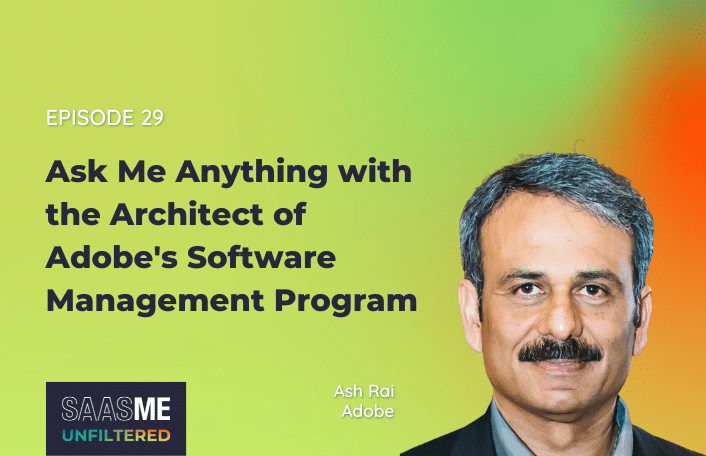07/27/2023
Table of Contents
Before using Zylo, Adobe managed SaaS products manually, and only tracked the high dollar spend applications. But in a time of rapid growth, SaaS adoption spreads like wildfire.
Between 2017 and today, Adobe grew from a $4.8 billion-dollar company to an $18 billion-dollar company. About four years ago, they realized software spend growth was outpacing revenue. In addition, hundreds of SaaS applications were being expensed on employee credit cards with no oversight, and employees were purchasing products not knowing the company already secured a negotiated rate.
“We knew we had to get our house in order and manage our assets methodically and deliberately through a comprehensive SAM program,” said Ash Rai, Director, Software Asset Management and Vendor Relations, Adobe Technology Services.
In search of a fully-managed system versus a point solution, Rai found Zylo, and leveraged its capabilities to build and implement a software asset management program Adobe calls Nestware.
“Zylo allows us greater insights into our software usage,” Rai said. “Our software spending is at our fingertips now. We’re compliant with our obligations to our software vendors. We harvest software licenses, resulting in millions of dollars in cost avoidance. It also allows us to build better strategies for contract renewals and negotiations.”
Rai recently shared insights and best practices for building a software management program in his keynote AMA session, moderated by Cory Wheeler, Zylo Chief Customer Officer and Co-founder, during The SaaS Management Event (SaaSMe) 2023.
1. Discovery and Rationalization
Through SaaS discovery, Adobe identified 2,600 apps and began the process of rationalization—determining which applications should remain in use, and which need replacement, retirement, or consolidation.
“We were able to identify redundant applications in use,” Rai said. “For example, after we deployed Zylo, we became aware that we were using 15+ survey tools. We successfully eliminated the majority of them, and now we only use a couple.”
During the rationalization process, Adobe dwindled their 2,600 apps down to 400+ standardized applications.
2. Money Savings and Cost Avoidance
By implementing a SaaS management program, Adobe unlocked approximately $60M in savings and cost avoidance. Savings refer to the elimination of software spend through app elimination and consolidation. And license harvesting and rightsizing results in cost avoidance.
“Through proactive software management, we have given ourselves the ability to rightsize our license purchases during renewals and contract extension,” Rai said. “We don’t just go and harvest licenses. We take the data we get through Zylo and our SAM program to understand how to construct license agreements for the future.”
3. Optimized Internal Resources
In addition to direct cost savings, harnessing Zylo’s AI features to categorize application titles saved the Zylo team approximately 500 hours. Adobe estimates saving an additional 10K+ hours annually through Zylo automations, which streamline end-to-end processes like license provisioning, inactive license reclamation, and chargeback of enterprise license costs
“Zylo is in the middle of all of this, allowing us to manage and monitor the software optimization process by giving us the flexibility needed to manage a software landscape,” Rai said. “It is our system of record for all software.”
Adobe Leads the Way
When it comes to SaaS management, Adobe employs a first-in-class system that’s integrated into their business culture and structure. It serves as an example of what businesses can accomplish when they get their SaaS in order.
“A SAM journey is never complete,” Rai said. “If you ever feel that you’re done, you’re going to be mistaken. New challenges come every day. What we are aspiring to is to establish a path to dynamic SAM. Additionally, we’re always open to suggestions from our stakeholders and industry experts like Zylo. We are deliberate in our approach to make continuous improvement in our processes, tools, and overall approach to software lifecycle management.”

